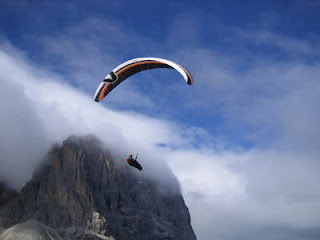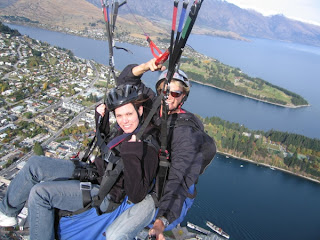Just what is a typical
paraglider pilot? The short answer is 'there are none'. The slightly longer answer might be 'well, a lot of them seem to be guys in their 30s or 40s'. Surprised? Isn't
paragliding one of those scary, risky, over-the-top activities in vogue with the young and daring? No, it isn't really, although there is some potential for danger as in any form of
flying.So don't expect to go to a
paragliding location and find
pilots fitting some sort of
Extreme Sports stereotype. Being more of an
aviation sport, and relatively cheap and easy to get into,
paragliding does attract a wide variety of participants. You too could learn to
paraglide and amaze your friends! Europe is where it all started, and it is there that you are more likely to spot some interesting people in the sport. In that corner of the world, children's camps sometimes include
paragliding as an activity! At the other end of the spectrum, there are many older pilots.

That is, those well past retirement age! What better way to keep life interesting.Heck, I've even seen a video clip of a dog going for a ride, clipped into a special doggy
harness alongside the pilot. Wonder how much
flying time a German Shepherd needs to log before going solo. Hey, don't laugh,
paragliding is almost that easy! Let's do a quick check of some possible categories for
paraglider pilots.Age is one, definitely. I've already mentioned how the very young to the very old can fly. Weight is another. Little men or slightly-built ladies flying their bottom-of-the-size-range XXS wings. Sounds like a shirt size doesn't it. Right through to people of substance who are too much for anything but a
tandem paraglider. Yes, a wing actually built for two. What else? Nationality of course, since this is a global
sport. Although birthed in Europe, and most popular over there, every continent on the planet has its
paragliding fanatics.
What about disability? Surely not! Oh yes, some companies are actively helping wheel-chair-bound people into the air. All it takes is a couple of working arms after all, to use the paraglider's brake toggles. Maybe just one more category, gender is an obvious one. As usual in flying sports, there are far more men than women in
paragliding despite gender giving no special benefit for flying. If anything, women are quicker to pick up the required careful and precise style of using the controls.That just about covers the main angles on the variety to be found in
paragliding pilots. Now for some real examples, some specifics.Age Particularly in Europe, you can observe people in a wide range of age groups flying their
paragliders.
Even all the way back in 1994 there were some
young pilots. In that year a 14 year old in Bulgaria became their youngest
paraglider pilot. He had 29 flights to his credit at that tender age.In Israel, paragliding has some history, starting with the Zoom Club pioneering efforts of Yair Shachar. He in turn taught a certain Baruch Gurwitz to fly, at the age of 70! In fact, in 1998 Baruch earned an entry in the Guinness Book of Records as the world's
oldest paraglider pilot. He was 77. That record has not lasted though! Since then, a short film has been made about the exploits of a 79 year old Polish pilot. Miroslaw Dembinski produced the film, winning a prize in the Banff Mountain Film Festival. Being a pilot is one thing, but of course age is even less of a barrier when you are only a
passenger! I came across one
paragliding school that recorded the names of two exceptional passengers. 95 year old Hannes Taugwalder for one.
Just to give you some idea of the weight range available to paraglider pilots, here's a couple of real paraglider designs to illustrate. Firstly, the Nova Rookie wing is available in 5 different sizes. The smallest is the XXS. Extra extra small. Just right for a featherweight pilot, most likely female, who weighs in at 55 kilograms (about 120 pounds) ready to fly. That's right, that weight includes harness,
helmet and any other gear she may be wearing.At the other end of the scale, really large pilots can in fact use a
tandem paraglider which is normally used for taking passengers. So, in theory, Big Bertha or Gigantic Joe who weighs 200 kilograms (about 440 pounds), could put on 10 kilograms (22 pounds) of flying gear and go for a gentle float in the Bio-Air Bi-Bio 42. This is a typical tandem paraglider.Now for a bit of trivia.
The biggest sports paraglider of all time was a one-off design with a 20 meter (66 feet) wingspan, used for filming a car commercial! This very special reinforced wing had to carry a whopping 600 kilograms (over 1300 pounds), after being dropped from a Lama heavy-lift
helicopter. A real Audi A6 All-road vehicle was filmed floating through the sky under this
paraglider, against spectacular mountain scenery.Nationality these days, it's hard to think of a continent that has no paragliding activity. There are excellent schools and flying
locations to be found all over the world. Also, I know that my paragliding
website attracts visitors from more than 60 countries!
Paragliding is particularly well known and visible as a sport in England, France, Germany and South Korea. Of course there are others, but these 4 have stood out to me so far.Disability organized paragliding for the disabled exists in the U.K., Australia,
South Africa, the U.S. and probably quite a few other countries as well.
Not surprisingly, tandem paragliders are used a lot in this area.The English seem to have done a very good job of promoting
paragliding for the disabled. Just look at the activities of Airways Airports, they are not hard to find! This company sometimes uses specially modified paragliding 'chariots' to give access to
flying to a very wide range of disabled people.Another notable company is Handiconcept, who provide a range of activities to the disabled, including paragliding. They operate from a
Swiss Alpine resort and cater for both the physically and mentally handicapped.Moving across to the U.S., an innovative company called Team Thor have set themselves up as a public charity. They cater for the physically handicapped in particular, and focus on coastal flying in
tandem paragliders. Not just any old coastal flying, but the very impressive and well-known ridge-flying experience of Torrey Pines, on the Pacific coast.

Gender paragliding offers no barriers at all to female participants. The minor issue of very light weight, in some cases, is easily fixed by carrying ballast. Some of the bigger
paragliding schools even offer paragliding courses specifically for women. An example is Peak to Peak Paragliding which operate out of Boulder, Colorado in the U.S.Particularly in Europe, a select few women have reached the highest standards in the sport by becoming active competition pilots. Such is the participation rate over there, there are even women-only events on the CIVL sporting calendar.
CIVL is an international body that governs aspects of paragliding and hang-gliding, like the FAI in general aviation.Now for a quick mention of 2 notable women in paragliding. Firstly, Azar Mazru'ii Farahani from Iran is the director of the Women's Air Sports Federation of Tehran.
A professional paragliding instructor, she glides through the air with the greatest of ease wearing traditional Islamic clothing. That's different.Secondly, one of the U.K.'s top female pilots is Nicky Moss. She was good enough to win the women's event of the British Open Paragliding Championship when it was held in Spain. Not only that, Nicky also holds a British record in paragliding. In Conclusion maybe you might never have the opportunity to become a professional pilot. But paragliding, even if only as a passenger, is surely within your reach!
















